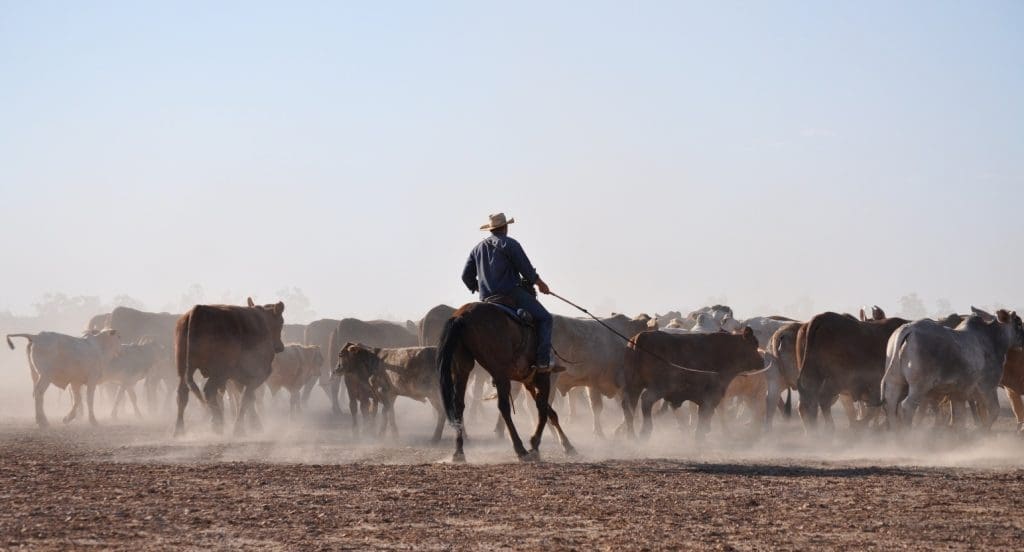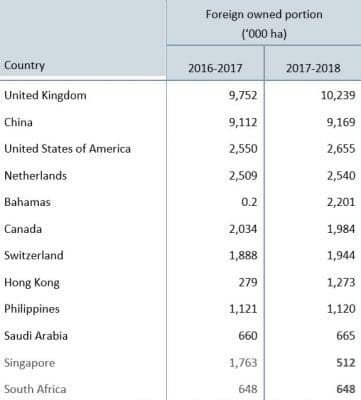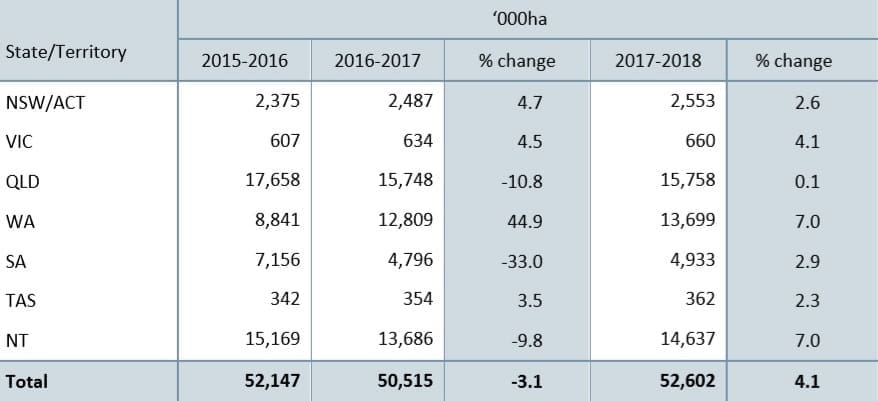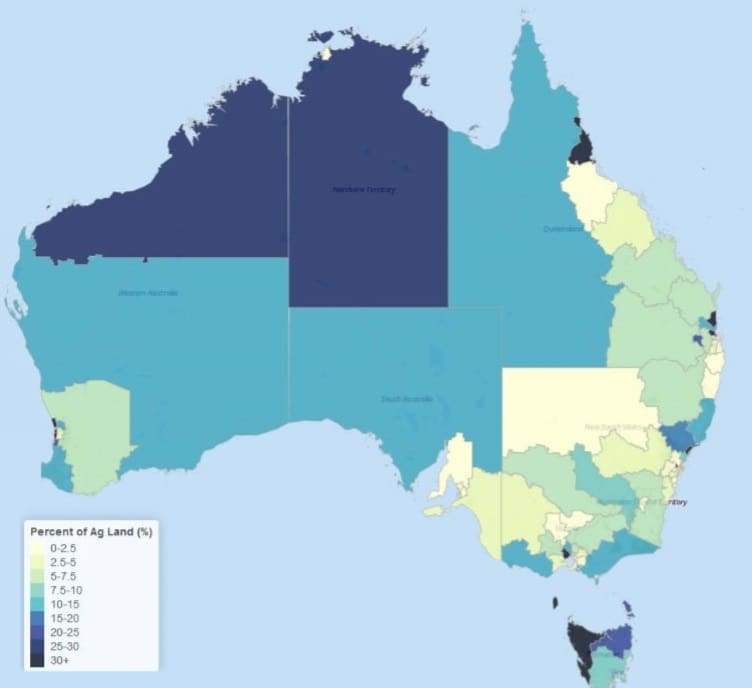
FOREIGN ownership of Australian agricultural land rose by more than two million hectares in the past year, but the longer-term trend is reasonably stable, according to a report released by the Australian Taxation office.
For the year ended June 30 2018, overseas owners had partial or outright ownership of 52.6 million hectares of farm land nationally, the report showed.
While the foreign owned land area has risen compared to the previous 12 months, it was much the same as what it was in 2015-16 (see table).
Not surprisingly, livestock industries accounted for the overwhelming majority of foreign agricultural land ownership, at just over 45 million ha, or 85pc of the total foreign-owned land. That figure has changed little in the past three years. Around 80pc of foreign-held agricultural land is held on a leasehold basis.
The Register of Foreign Ownership of Agricultural Land was established four years ago by the Foreign Investment Review Board to provide greater transparency about the level of foreign ownership of Australia’s agricultural land.
It’s important to note that some of the changes tracked in the most recent report, comparing 2017-18 to earlier years, can be attributed to adjustments in the way the data is collected. Much of this surrounds how the report treats a minority shareholding held by a foreign interest, versus majority or outright ownership.
Previously, any foreign entity with a 20 percent or higher stake in a piece of agricultural land was included in the statistics, and apportioned the entire land area involved. For example, a UK minority shareholder with a 25pc interest in a million hectares of Australian farmland was credited with a million hectares of land. Last year, the process changed so a pro-rata allocation was made, meaning that UK entity would in this example be attributed with 250,000ha of land.
UK largest landholder
The United Kingdom remained the largest foreign agricultural landholder in Australia last year, accounting for 2.6 percent of all Australian agricultural land. Next highest was China (2.3pc) and the United States (0.7pc). All three have moved only slightly higher in land area over the past two years (see table).
Just two very large landholdings (the Australian Agricultural Co, which is now 46pc owned by UK billionaire Joe Lewis), and Consolidated Pastoral Co (owned outright by UK investment vehicle, Terra Firma), largely account for the UK’s dominant position on the list.
Similarly, a large slice of China’s footprint can be apportioned to Shanghai CRED, Gina Rinehart’s partner in the S.Kidman and Co pastoral assets totalling 80,000sq km.
Largest country of origin mover on the list last year was the Bahamas, which has moved from virtually zero land ownership the year before to 2.2 million hectares in 2017-18, taking position number five. As there has been no publicly-disclosed agricultural land sales to Bahamas entities in the past year, it is surmised that this entry represents a change in business address for a pre-existing foreign landholder, to the well-known tax haven.
At the other end, Singapore declined dramatically in the extent of its ownership of Australian ag land, falling by 1.25 million ha last year to 512,000ha.
The FIRB report suggested that changes in agricultural land interests by country of ownership compared to the 2016-17 report can be attributed to:
- New registrations of acquisitions of agricultural land that have settled since 1 July 2017
- Agricultural land that has been sold to Australian entities and has been removed from the register
- Agricultural land that has been sold to other foreign entities with a different foreign country of ownership; and
- Foreign entity restructures which have resulted in a change of the foreign entity’s status as a foreign person.
There’s also clear evidence in the report of Australian domestic farming families and businesses re-purchasing land assets previously held by offshore interests.
For example, South Australia showed a dramatic decline in the area of agricultural land held by foreign interests in the two years between 2015-16 (7.156 million ha) to 2017-18 (4.933m ha). Much of that can be linked to the sale of land previously held by foreign interests, now returned to Australian ownership.
Based on comparisons with ABS data, the estimated proportion of agricultural land in Australia with at least 20pc of foreign ownership last year was 13.4pc. That figure has remained relatively stable over the past three years, at between 13.4 and 13.6pc.
State and territory breakdown:
All states and territories showed increases in the amount of agricultural land with a level of foreign ownership, however the extent varied significantly across different regions.
Both Western Australia (890,000ha) and the Northern Territory (951,000ha) recorded increases of 6.9pc in foreign ownership last year, while Queensland showed only a marginal increase, up by just 10,000ha or 0.06pc (see table).
The report also included a breakdown of the proportion of foreign-held agricultural land on a regional basis, using ABS Statistical level standards (see map below).
There’s been no shortage of examples in the past year of Australian entities buying back significant pastoral land assets previously held by foreign interests. Some of these will not appear as changes on the foreign ownership register until next year:
- In November, Consolidated Pastoral Co (owned by UK institutional investor Terra Firma) sold its 852,00ha Nockatunga Station near Thargomindah in Queensland’s far west to Malcolm Harris and family’s Cleveland Agriculture.
- Last month, NSW-based stud Merino breeders Ian and Camilla Shippen paid $37 million for Mt Fyans, one of the largest and most highly regarded agricultural holdings in the Western district of Victoria. The Dundonnell grazing and cropping enterprise was previously owned by HAFCo, a Chinese/Australian joint venture.
- In October, Qatar-based Hassad Australia sold its Telopea Downs Station in western Victoria for $70 million to South Australian woolgrowers, the McBride family. Hassad has now sold about two thirds of its Australian farming and grazing assets, which earlier covered some 300,000ha in three states.
- Other properties currently on the market with foreign owners include 5000sq km Tanumbirini Station east of Daly Waters in the NT, which is being offered for sale by owners, Thames Pastoral Co, controlled by a UK investment fund.
Labor seeks greater disclosure
The Labor party last year indicated that if elected, it plans to expand the ATO’s annual report on foreign agricultural land ownership by identifying buyers of land, value and locations.
“The register should set out for everyone to see not just the percentage of land owned by overseas companies but who has purchased it, where it is and how much they paid for it,” opposition trade spokesman Jason Clare said in September.
The Federal Government is currently preparing a second foreign ownership register, this time for water access rights. The report is expected to be released in coming months.





Each year more land,farms ,companies,ports , even our water is being sold to foreign investors. How can this be ? This water should only be used by Australian farmers for agriculture and farms etc. The govt should be giving help to farmers to keep them on the land, and our exports from this enterprise would benefit everyone. Our land ,companies cattle stations , dairy farms etc should only be leased for no longer than 10 years to foreign investors , never sold outright .Our food chain and manufacturing needs to be kept in our own hands so we are not beholden to another country. The Foreign Investment Review Board signed off on the leasing of the Port Of Darwin for 99 years to China , it is incomprehensible that a foreign country would have control of a strategic asset like this in the Northern Territory.
The Gov is only a caretaker of our land and has no right to sell it to another country . I have no faith in the Foreign Investment Board if they signed off on putting The Port of Darwin in foreign hands then we know we have a problem.
of Darwin
A very good publication. Would be good to see the latest figures for 2018/19. I see a trend of foreign holdings being sold off as opposed to the opposite. Would be good to see a timeline list of significant purchases and sales
Thanks
Who is regulating the management of the land owned by overseas investors? As in is the land and waterways respected and treated to a certain standard?
Is it possible to obtain regional data so that we can analyse where the purchases are being made?
Does the Australian government purchase land from other foreign countries,hmmm not sure about that.Do think we need to be careful about selling off our land,companies etc,instead the government should be helping the land owners,farmers and companies to stay in their chosen fields.Sad to think of our beautiful country being sold out!!!and our own people going down.